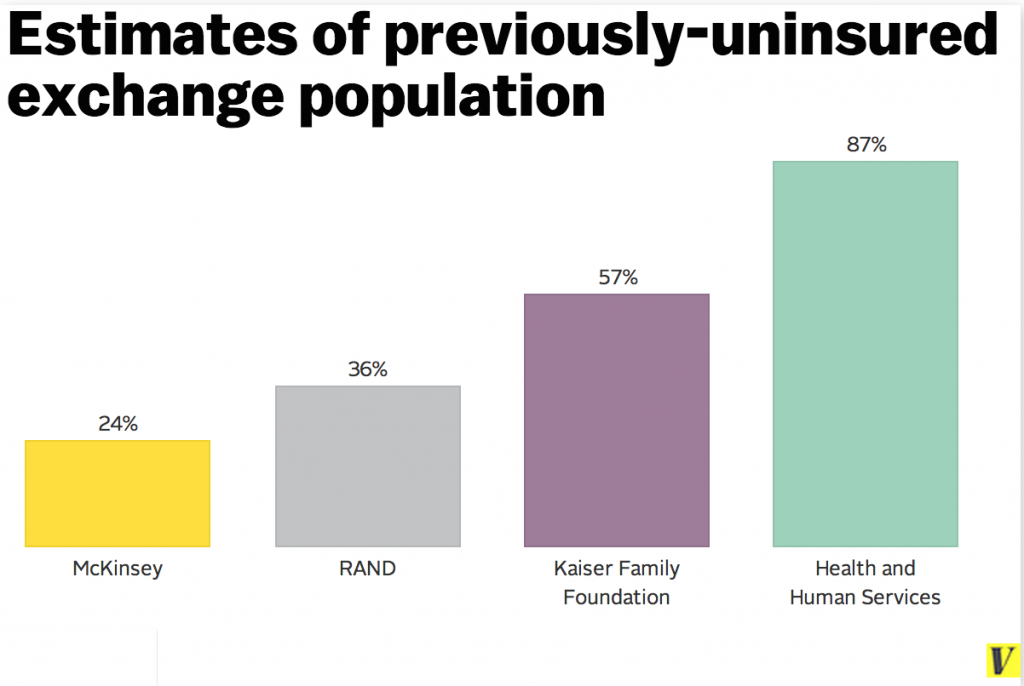How Many ObamaCare Enrollees Were Uninsured? Between 24 And 87 Percent
Sarah Kliff has compared recent estimates of how many ObamaCare enrollees were previously uninsured. The range? 24 percent to 87 percent.
Kliff notes that “when you dig into the methodology, as health wonks are wont to do, you start to notice that the surveys happened at different times, with different people who were asked different questions.” Fair enough, I would add that there is a big difference between someone who was uninsured for a few weeks before signing up for ObamaCare, and someone who has been uninsured since, for example, losing his job in the 2008 recession. The surveys do not really help us here.
The whole question of measuring the uninsured is one I wrote thoroughly about way back in 2006, and is probably due for an update. The gist is that even government-sponsored estimates of the uninsured, such as the Census Bureau’s Current Population Survey and the Centers for Disease Control and Prevention’s National Health Insurance Survey, are challenging to reconcile. So, we should not be too hard on private-sector analysts who give it a shot.
Source: Sarah Kliff, Vox.



“…you start to notice that the surveys happened at different times, with different people who were asked different questions.”
Well that would tend to yield different results, like shown in the graph.
I would take these estimates to conclude that no one really knows. But there were people who were uninsured, and it could either be by a lot or by a little.
Thus showing its massive variance. I’m willing to bet this is due to differing methodologies and resources.
I think it will be interesting to see how many actually stay insured under Obamacare.
I think the Obama Administration will be underwhelmed by how many stay insured. Maybe that’s when the Health and Human Services comes in to fudge some numbers.
If you look at the two extremes and divide them in half, the left side paints a bleak picture of the cost to cover the uninsured. The right side — not so much. Yet, if you look at the sources of the surveys, the right two organizations are proponents of the PPACA whereas the left two entities are independent firms who have no political or economic bias. I would tend to believe RAND and McKinsey more than HHS/KFF
I wonder how much bias is accounted for the right side of the graph. They do paint a picture that ACA came to the rescue for the uninsured.
Me too Devon! The HHS survey is conducted by the same bureaucrats who are imposing this law upon a public that thoroughly is against it, and therefore they are likely to be the most prone to set up a survey that generates the most positive buzz regarding the ACA.
I also wonder how many of the newly insured people were previously insured but had their coverage stripped due to Obamacare in the first place!
No wonder things looked so dire from the Health and Human Services!
Guess which survey is being touted by the president and his loyal advocates in the popular media?
This is reminiscent of the president’s claim that this law somehow amounted to universal healthcare. First we were told there were 45 million Americans without insurance, then the number dwindled down to 30 million after people caught on to all the illegal residents that inflated the first number.
But this law will still not provide universal coverage. So, what else can the administration do but try to fudge the numbers of previously uninsured people now covered by their “signature legislative achievement”?
Apparently, these companies have completely different sampling strategies or mathematics functions. If the ObamaCare does provide a reasonable and affordable insurance to previously-uninsured, the ratio is supposed to be higher and the variance should be much lower.
Thank you, but I don’t think its a sampling problem. I really think it is that they are not asking the same question. How long and why someone is uninsured is much more important than whether he is uninsured on the day he answers the phone for the survey (at least for policy purposes).
All the statistical machinations are irrelevant. What’s relevant is how many people are still uninsured and even with the highest percentage used (87 percent), we are still looking at close to 40 million uninsured if you use the 45 million uninsured figure that has been bandied about. So Obamacare has insured about 7 million of the previously uninsured 45 million which is about 15 percent . This plan is not gonna work, I’m afraid to say.
Statistical machinations aside, why is the number of newly insured even a relevant statistic? For instance, maybe six million people are newly covered by Medicaid. Some of these were already eligible under old laws but never signed up. If 1 million people now have coverage but would never have bothered to sign up (last year) and wouldn’t have even turned in a claim, why do we celebrate? What was accomplished? We have boosted health coverage, but we have not increased the number of doctors — whose offices were already full most of the time.
A better metric is whether or not people are getting access to care when they need care rather than whether they have bad coverage, average coverage or Cadillac coverage.
Well, they likely got registered to vote, which is an accomplishment for the ObamaCare party!
But seriously, I agree. Plus, I have always resisted bundling those on Medicaid and those with private insurance under the same label: “insured”.
Medicaid is welfare. If unemployed people receive welfare payments, we don’t say they are now “employed”. As long as we group Medicaid dependents with the privately insured, the government can always increase the numbers of uninsured by increasing the number of people on Medicaid.